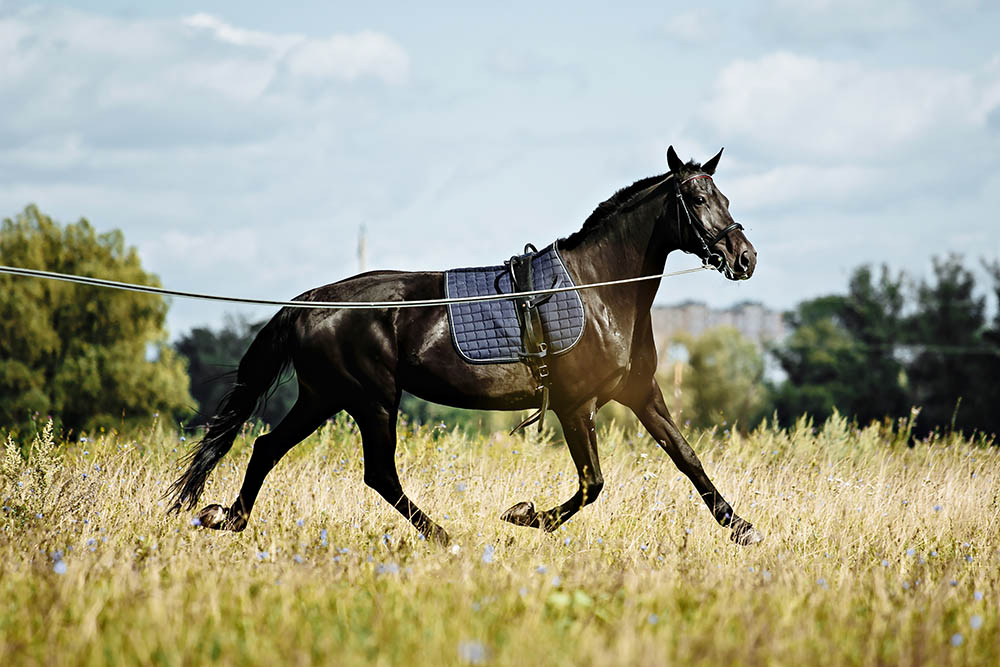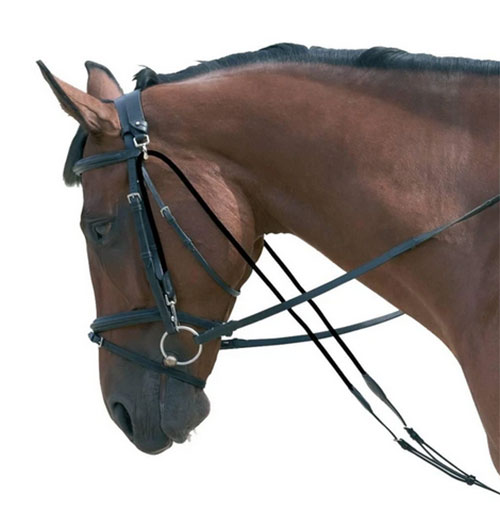Lungeing horses correctly and safely is an important skill. There are many reasons to lunge a horse as part of the program of training him for balance, suppleness and obedience. Lungeing can really improve a horse’s understanding of the contact with the bit.

“The worst reason to lunge is…
one of the most common reasons.”

A long time ago I bought an experienced showjumper who had awful problems with the contact and was so horrible to ride that I decided not to ride him between shows. I lunged him with a chambon for several weeks while we continued to compete on the weekends. I didn’t expect to change him; I just wanted to keep him fit without the discomfort of riding him.
The transformation in him was absolutely amazing. Once he became confident to take the contact and learned to give forwards and downwards into the bit, I could then start to influence him with my aids to collect and balance and adjust the canter. He became fun to ride, he transformed from a ewe-necked, rubbery thing to a horse with a beautiful topline. This correct muscle development further helped him to produce a better performance. I had a lot of success with him at the highest level.
I don’t believe that I could have helped him learn this by riding him, as he was too hot and reactive to all the other things I might have done rather than just allowing him to focus on the contact.
Lungeing can be a way to help maintain fitness or be a part of a rehabilitation program. Lungeing is an opportunity to observe your horse’s muscle development, balance and how he reacts to things, and to get him to focus his attention on you and build that capacity to pay attention to you.
POOR TRAINING
The worst reason to lunge is, I suspect, one of the most common reasons riders lunge horses, and that is to “take the sting out of them”. To lunge a horse simply to wear him out or make him tired is very poor training. We used to see horses lunged all night before big classes at the royal shows to make them tired and less likely to misbehave in the ring. It is far better to prepare him before the show in a way that you are confident that he will do what is asked because he understands and is trained well enough that he can cope with distractions.
In this article, we look at how you can use lungeing to improve your horse, but I will assume that your horse knows how to lunge. Of course, safety is the most important thing. Always lunge in a safe place, and wear suitable boots. It’s best to put your helmet on – may as well. Do not wear spurs as they can snag the lunge rein when things go wrong. Never allow a knot in the lunge rein as this can snag too.
Always hold the lunge rein in a way that it is folded over your hand and never in a way that it loops around your hand. Practise being able to manage the lunge rein and whip in a way that you never allow a loop around your hand to form even when letting the rein out and in. When you are lungeing, try to stand still in one place unless there is a reason to move. You want him to learn to go around a regular circle in balance, and if you move around you rob him of the opportunity to learn this. There are times that you might move towards his rump to keep him going forwards, or step towards the front to teach him to stop, but try to stand still when you are not using your body to get him to react.
You can clip the lunge rein straight onto the bit. I prefer to have it through the inside bit ring and clipped onto the outside ring. You will have more control with a wayward horse if you feed the rein through the inside bit ring and over the poll to the outside bit ring. Or you can use a lungeing connector on the bit or a lungeing cavesson. I prefer the Spanish-style cavesson with a low set noseband to the traditional English-style one.

“The simplest aid is the side reins.”

SIDE REINS
I do not like to lunge a horse without side reins, or other aids, to help him find a better balance and contact. Do not let them buck or carry on while lungeing. Correct them by making the circle small so they are under proper control. Make the wrong thing difficult.
The simplest aid is the side reins. These should be initially adjusted so that they just make a contact with his head in a natural position. Make sure that he will go forward in a light contact before you shorten the side reins so that they do start to influence him to make a better frame. The more actively forwards you make him go, the more the frame and the contact will improve and the more effective the lungeing will be to build muscle.
From the ground you can drive him actively so the hind leg does get more active and the topline engages. If you watch closely you can see where he relaxes into the engagement and softens and swings, with the muscles of the neck reaching into the contact and the nuchal ligament carrying the weight of the neck. You can help him find this point by doing lots of transitions. Forward with more energy, back with more balance. Trot, canter, trot. Do the transition to canter, establish the new rhythm and then transition back to trot. The energy in the canter will help him find the way to be energetic in the trot. Repeat this often. Think of the transitions like the repetitions that you do in the gym.
You can also really push the trot to help him find another gear. When you start to ask for a really active trot, he is likely to offer canter. Cantering is easier for him than a really active trot. Just say “no” and correct him. Make the right thing easy by making the circle very small as soon as he canters (if you are wanting an active trot). When he goes back to trot, allow the circle to get bigger so that it’s easier for him to lengthen the steps.
VOICE COMMANDS
I am a very strong believer in using specific voice commands to make it easier for him to know what you want. Horses can develop quite a vocabulary if you are consistent. We use “walk on” (not “walk” as it may sound like “whoa”), “trot” (not “trot on” as it sounds like “walk on”), “canter”, “steady” (means slow down in any pace), “giddup” (means to speed up in any pace), “whoa’ (means all four legs stopped), as well as “good boy” (or “braav” for European horses) and “no”.
I also train them so that if I put my hand up like a stop signal, they stop – useful if a horse gets loose, and that they stop if the lunge rein is on the ground. Of course, your body language and tone of voice also communicates your intention. If I want trot from walk, my voice and body say “more energy”, but if I am doing trot from canter my voice will be slower and more soothing and my posture will have less energy. I hate clucking as this is very non-specific and your horse could react to someone nearby clucking, so use specific voice aids.
Doing lots of transitions with these specific words as aids will help him know the words so you can use them under saddle to help him know what you want as well. This doesn’t just help you with young horses learning to understand the canter aids, but later on, for example, training piaffe and passage if he offers canter because he misunderstands you can tell him “trot” so he will be less confused.
Trot-walk-trot transitions will also improve the balance. Ask for walk but quickly go back to trot, and repeat. This helps him find a way to keep his balance in the down transition as he starts to anticipate going back to trot. He will learn to not fall into the walk.
In addition to LOTS of transitions, you can help him develop balance by varying the size of the circle. You can use a corner to help him make the circle smaller, but do stand still. This time you want him to keep active on the small circle, not slow down, so you will need to tell him with your voice, posture and your whip to keep going. When using the whip always use the smallest aid that is effective, just as any aid, so that he becomes more tuned in to you and more sensitive.


THE PESSOA
The Pessoa (pictured) is a popular tool that can encourage the horse to step up. This can be easily adjusted. Always start loose and be aware that some horses really hate the part around their rump. If they kick too much it can end up under their tails, which they also don’t like, so introduce it in a safe place and go slowly.
I particularly like the chambon. You can make one easily with a piece of sash cord, two snap clips and two pulleys. If buying one, make sure there is plenty of adjustment. As you know it is the release of pressure that trains the horse. The chambon has three fixed points: the girth between the front legs, the poll and the bit. When these three points come into a straight line the pressure is the least. So the horse is rewarded for stretching forwards and down into the contact. This is very different from the side reins and Pessoa, which can reward a horse who comes behind the vertical and drops “behind” the contact.
As with all pressure-release training, sometimes you have to apply enough pressure that the horse wants give to the pressure. There are times that you might want to explain to the horse that he needs to give forward and downwards, by shortening the chambon. This is especially true for horses that have learned just to lean on the contact, for example, in retraining racehorses.
I hope this introduction gives you some things to play with. There are lots of other aids, ways of setting up the reins, and exercises you can learn. It takes just as long to lunge a horse simply for exercise as it does to lunge a horse to help him learn about the contact, improve his balance and strength and teach him the specific voice commands, which make it easier to understand what you want — so why not do the latter!
Have fun. EQ
READ MORE BY DR KERRY MACK:
Dressage for Showjumpers – Equestrian Life, May 2021 issue
23 Shoulder-In Exercises to Improve Your Horse – Equestrian Life, April 2021 issue
Understanding Your Horse’s Inner Thoughts – Equestrian Life, March 2021 issue
Make the Most of Your Seniority – Equestrian Life, February 2021 issue
Building Better Relationships – Equestrian Life, January 2021 issue
Whipping Up Controversy – Equestrian Life, December 2020 issue
The Importance of a Trusting Relationship – Equestrian Life, November 2020 issue
Welcome to Kindergarten for Foals – Equestrian Life, October 2020 issue
The Carrot or the Liquorice? Positive Reinforcement – Equestrian Life, September 2020 issue
Submission or Stress? Something to Chew On – Equestrian Life, August 2020 issue
A Relaxed Horse is a Happy Horse – Equestrian Life, July 2020 issue
The Literate Horse Rider – Equestrian Life, June 2020 issue
Why Horses Love Ingrid Klimke – Equestrian Life, May 2020 issue

